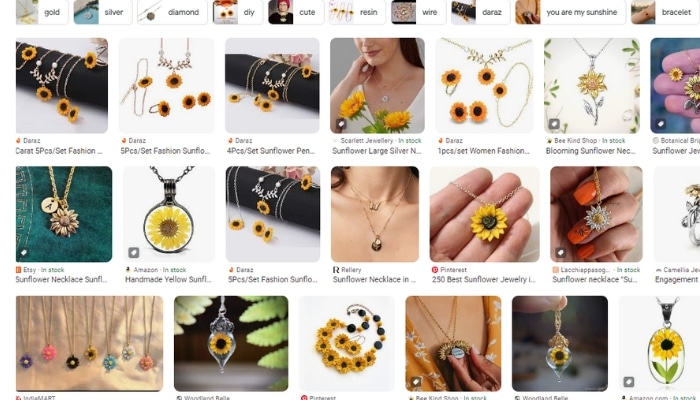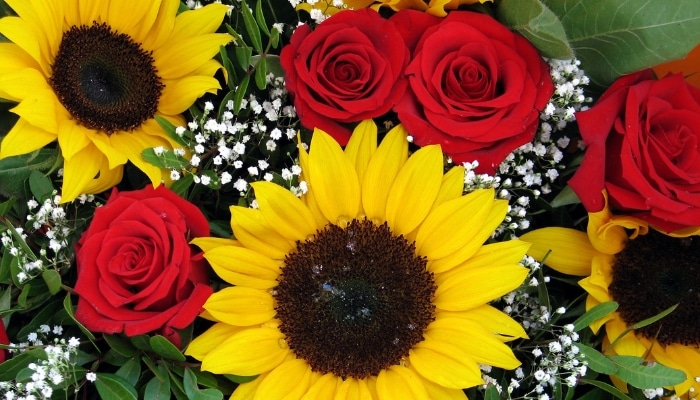Sunflower colors range from yellow to red and brown, and they can attract pollinators like bees and butterflies. Sunflowers are known for their vibrant hues and play a significant role in pollination.
Read more:
The Fascinating World Of Sunflower Colors
Experience the captivating world of sunflower colors, showcasing a vibrant spectrum that ranges from golden yellows to deep oranges. Discover the beauty and diversity of these stunning blooms that add a burst of sunshine to any garden or landscape.

Overview Of The Diverse Range Of Colors Found In Sunflowers:
- Sunflowers, with their vibrant and eclectic hues, showcase a captivating array of colors that range from the classic yellow to the lesser-known maroon, bronze, and even bi-colored varieties.
- The vibrant colors of sunflowers are mainly due to pigments called flavonoids, which are responsible for the production of red, purple, and blue shades.
- The remarkable diversity in sunflower colors stems from the combination and intensity of these pigments, as well as the presence of various color modifiers.
- From traditional sunny yellows to striking and bold reds, sunflowers offer an extensive palette of colors that can effortlessly brighten any garden or bouquet.
How The Genetics Of Sunflowers Influence Their Colors:
- Sunflowers owe their incredible color variations to their genetic makeup and the expression of certain genes.
- Specific genes control the production and accumulation of pigments in sunflowers, influencing the overall color of the flowers.
- Genetic variations and mutations can lead to altered pigment production, resulting in unique colors and patterns.
- The dominant gene responsible for yellow pigmentation can be masked or modified by other genes, leading to different hues and shades in sunflowers.
- Selective breeding has also played a significant role in enhancing certain color traits in sunflowers, allowing breeders to create a broader range of colors to suit various preferences.

Factors That Affect The Intensity And Vibrancy Of Sunflower Colors:
- Sunflowers are influenced by various factors that can enhance or diminish the intensity and vibrancy of their colors.
- Sunlight exposure plays a crucial role in maximizing the colors of sunflowers. Adequate sunlight exposure stimulates pigment production, resulting in brighter and more vibrant hues.
- Climate conditions, including temperature and humidity, can affect the development and intensity of sunflower colors. Cooler temperatures might lead to deeper and more intense colors in some varieties.
- Soil composition and nutrient availability can also influence sunflower colors. Nutrient deficiencies or imbalances can cause pale or faded colors, while well-nourished plants tend to exhibit more vibrant and saturated hues.
- The overall health and vitality of sunflowers impact their color intensity. Strong and healthy plants tend to produce more robust colors, while stressed or diseased plants may display duller or faded shades.
The world of sunflower colors is a captivating and diverse one. From the intricate genetics that dictate their hues to the various factors that influence their intensity, the wide range of colors found in sunflowers is a testament to their beauty and uniqueness.
So whether you prefer classic yellow blooms or are drawn to the allure of bi-colored varieties, sunflowers truly offer something for everyone.

Yellow Sunflowers: The Classic Beauty
Yellow sunflowers captivate with their classic beauty. These vibrant blooms add a cheerful touch to any garden or bouquet.
Yellow sunflowers have long been admired for their classic beauty, captivating the hearts of art enthusiasts and symbolizing various meanings. Let’s explore the significance of these vibrant blossoms in art and symbolism, as well as the different shades of yellow found in sunflower varieties.
The Significance Of Yellow Sunflowers In Art And Symbolism
- In art, yellow sunflowers often symbolize joy, happiness, and a positive outlook on life, making them popular subjects for paintings and other artistic creations.
- Vincent van Gogh’s iconic series of sunflower paintings is a testament to the enduring appeal of these golden blooms in the art world. His vibrant brushstrokes and use of vivid yellows capture the essence of sunflowers’ radiance and vitality.
- These cheerful flowers have also made their mark in various cultures and symbolize adoration, loyalty, and longevity. In Chinese culture, yellow sunflowers convey good luck and a strong bond in relationships.

Different Shades Of Yellow Found In Sunflower Varieties
- Sunflowers boast a wide range of yellow hues, delighting us with their diverse and captivating shades. Here are some of the different variations you may come across:
- Lemon yellow: This delicate shade exudes a soft and subtle charm, evoking a sense of freshness and purity.
- Canary yellow: Bright and vibrant, these sunflowers demand attention with their lively and energetic appearance.
- Golden yellow: Reminiscent of the warm glow of the sun, these sunflowers exude a sense of warmth and positivity.
- Amber yellow: With a hint of orange undertones, this shade adds depth and richness, creating an exquisite visual experience.
The Role Of Pigments And Compounds In Creating Yellow Hues
- The captivating yellow hues found in sunflowers are a result of complex pigments and compounds present in the flower’s petals. Here’s how they play their part:
- Carotenoids: These organic pigments are responsible for the vibrant yellows and oranges seen in sunflowers. They absorb blue and green light, reflecting yellow and orange wavelengths.
- Xanthophylls: One of the major groups of carotenoids, xanthophylls contribute to the yellow coloration seen in sunflowers. They enhance the visual appeal and serve as an attractant to pollinators.
- Flavonoids: These secondary metabolites work hand in hand with carotenoids to produce intense yellow shades. They assist in protecting the flower from UV radiation and act as antioxidants.
Yellow sunflowers are not only a visual delight but also hold deep symbolic meanings across various cultures. From their significance in art to their different shades and the intricate pigments responsible for creating those hues, these vibrant blooms continue to captivate and inspire.

Red And Orange Sunflowers: A Fiery Delight
Red and orange sunflowers create a fiery delight with their vibrant hues, adding a burst of color to any garden or bouquet. These stunning flowers offer a unique twist on the traditional yellow sunflower, captivating the eye with their warm and energetic tones.
Exploration Of The Vibrant Red And Orange Sunflower Varieties:
Sunflowers are known for their bright and cheerful colors, and among the most captivating of these hues are the fiery red and orange varieties. These vibrant sunflowers add a pop of warmth and intensity to any garden or floral arrangement, making them a popular choice for those seeking to create a bold and eye-catching display.
In this section, we will delve into the fascinating world of red and orange sunflowers, exploring the science behind their pigmentation, as well as the cultural associations and meanings they hold.
How Anthocyanins Contribute To The Red And Orange Pigmentation:
The mesmerizing red and orange hues displayed by certain sunflower varieties can be attributed to a group of natural pigments called anthocyanins. These pigments are responsible for the brilliant red, purple, and orange colors found in numerous plants and flowers.
In sunflowers, anthocyanins work their magic by absorbing light in the blue-green spectrum and reflecting the warm red and orange wavelengths. This captivating interplay between light and pigments results in the stunning red and orange shades that make these sunflowers truly stand out.

The presence and distribution of anthocyanins in sunflowers are influenced by genetic factors, environmental conditions, and interactions with other pigments. Through careful cultivation and breeding techniques, horticulturists have been able to develop sunflower varieties with an amplified presence of anthocyanins, leading to even more vibrant and intense red and orange petals.
Cultural Associations And Meanings Behind Red And Orange Sunflowers:
Colors have long held symbolic meanings in various cultures, and red and orange are no exceptions. Red, often associated with love, passion, and energy, adds a powerful and captivating element to sunflowers. It can represent intense emotions, and deep desires, and even signify strength and vitality.
Orange, on the other hand, evokes feelings of warmth, enthusiasm, and creativity. It is a color often associated with joy, success, and a zest for life.
In the language of flowers, red and orange sunflowers can convey a multitude of messages. They can symbolize love and desire, representing the burning passion within, or they can embody a sense of enthusiasm and joy, spreading warmth and happiness to those who encounter them.

Whether used in romantic bouquets or as vibrant additions to festive celebrations, red and orange sunflowers hold a special place in the hearts of many, captivating and inspiring with their fiery hues.
The exploration of vibrant red and orange sunflowers allows us to appreciate the captivating science behind their pigmentation, while also uncovering the cultural associations and meanings they hold. These fiery beauties with their intense hues and powerful symbolism are sure to ignite a sense of awe and wonder in anyone who comes across them.
So, why not embrace the warmth and vibrancy of red and orange sunflowers and let them add a fiery delight to your garden or floral arrangements?
White And Cream Sunflowers: Elegance In Simplicity
Discover the elegance of white and cream sunflowers, which exude simplicity and beauty. The subtle colors of these blooms add a touch of sophistication to any floral arrangement or garden setting.
The Allure And Uniqueness Of White And Cream Sunflowers:
White and cream sunflowers stand out amidst a sea of vibrant and colorful blooms with their elegance and simplicity. Their understated beauty is captivating, drawing attention and curiosity. These sunflowers possess a unique charm that sets them apart from their more pigmented counterparts.
Chemical Compounds Responsible For Producing White And Cream Hues:
The white and cream hues in sunflowers are a result of specific chemical compounds. These compounds play a crucial role in determining the colors of petals. Here are the chemical compounds responsible for producing the delicate hues found in white and cream sunflowers:
- Flavonoids: These pigments, found in the petals of sunflowers, are responsible for generating white and cream tones. Flavonoids absorb certain wavelengths of light, giving the petals their characteristic colors.
- Anthocyanins: Although typically associated with red and purple colors, anthocyanins in white and cream sunflowers act as color inhibitors. They work together with other pigments to dilute or suppress the expression of vibrant shades, resulting in a softer, lighter hue.

Symbolism And Cultural Significance Of White And Cream Sunflowers:
White and cream sunflowers hold symbolic meanings and cultural significance in various traditions around the world. These meanings range from purity and innocence to spirituality and mourning. Here’s a glimpse into the symbolism and cultural significance attached to white and cream sunflowers:
- Purity and Innocence: The white and cream shades of these sunflowers are often associated with purity, innocence, and sincerity. They are considered symbols of spiritual enlightenment and transcendence.
- Sympathy and Mourning: White and cream sunflowers are commonly used in funeral arrangements and sympathy bouquets. Their delicate tones evoke a sense of calmness and provide solace during times of grief.
- Serenity and Peace: The soft hues of white and cream sunflowers exude serenity and convey a sense of inner peace. They are often used in meditation spaces to create a tranquil atmosphere.
- Weddings and Celebrations: White and cream sunflowers make a popular choice for weddings and celebratory events, symbolizing new beginnings, joy, and happiness. Their understated beauty adds a touch of elegance and sophistication to any occasion.
White and cream sunflowers may lack the vibrant colors typically associated with their counterparts, but their allure lies in their simplicity and uniqueness. These delicate hues and their symbolic meanings make them a captivating choice for special occasions or for those seeking a calm and serene presence in their surroundings.

Bi-Colored And Multi-Colored Sunflowers: Nature’s Artistic Palette
Bi-colored and multi-colored sunflowers showcase nature’s artistic palette, displaying a vibrant array of hues. These stunning blooms captivate with their unique combinations of colors, adding a touch of beauty and diversity to any garden or landscape.
Sunflowers are renowned for their vibrant yellow petals and unmistakable beauty. However, did you know that there are sunflower varieties that showcase two or more colors? These bi-colored and multi-colored sunflowers are like nature’s own artistic palette, adding depth and visual interest to any garden or floral arrangement.
Let’s explore the fascinating world of these captivating blooms and delve into the mechanisms behind their formation and the various interpretations they evoke.
A Showcase Of Sunflower Varieties With Two Or More Colors:
- Red and yellow combination: The most common bi-colored sunflowers feature a captivating contrast between radiant red and golden yellow hues. The warm tones blend seamlessly, creating a stunning visual effect.
- White and purple fusion: Another enchanting combination is the harmonious pairing of crisp white and deep purple petals. This blend exudes elegance and sophistication, making it a favorite among florists and garden enthusiasts alike.
- Pink and cream fusion: For a softer and more delicate look, sunflowers with blush pink and creamy white petals are a perfect choice. These gentle tones create a romantic and dreamy ambiance in any setting.
- Orange and brown blend: A unique pairing that adds warmth and earthiness to any arrangement is the combination of vibrant orange and rich brown petals. This color combination evokes feelings of autumn and complements rustic-themed displays.

The Mechanisms Behind The Formation Of Bi-Colored And Multi-Colored Patterns:
- Pigmentation variations: The different colors observed in bi-colored and multi-colored sunflowers are a result of variations in pigmentation patterns within the petals. These variations occur due to genetic factors and the distribution of pigments in the flower’s tissues.
- Genetic mutations: Mutations in the genes responsible for producing plant pigments can lead to the development of bi-colored or multi-colored patterns. These mutations alter the way pigments are produced or distributed, resulting in the unique color combinations observed in these sunflower varieties.
Interpretations And Interpretations Of Bi-Colored And Multi-Colored Sunflowers:
- Symbol of duality: Bi-colored sunflowers can symbolize the duality and balance between two contrasting elements. They represent the harmonious coexistence of different forces and perspectives.
- Artistic expression: Multi-colored sunflowers are often admired for their artistic appeal. The blending of vibrant hues creates a visually striking canvas, reminiscent of a painter’s palette.
- Individuality and uniqueness: Bi-colored and multi-colored sunflowers stand out from the traditional single-colored varieties, symbolizing individuality and embracing uniqueness. They reflect the beauty that can arise from embracing diversity.
Bi-colored and multi-colored sunflowers capture our imagination with their captivating beauty and unique combinations of colors. Whether you appreciate them for their artistic appeal or find deeper symbolism in their duality and individuality, these vibrant blooms are undeniably nature’s masterpieces.
So go ahead, explore the wide array of bi-colored and multi-colored sunflower varieties, and let yourself be enchanted by the wonders they hold.
Novel Sunflower Colors: Unconventional Beauties
Experience the vibrant beauty of unconventional sunflower colors with Novel Sunflower Colors: Unconventional Beauties. Delight in the unique hues that transcend traditional yellows, from deep purples to soft pinks, creating a stunning visual feast for your garden or floral arrangements.
Have you ever come across sunflowers that showcase colors other than the traditional shades of yellow and gold? While sunflowers are well-known for their vibrant and sunny appearance, there is a captivating world of rare and unconventional sunflower colors waiting to be discovered.
In this section, we will explore the fascinating realm of novel sunflower colors, uncovering how hybridization and genetic modification have paved the way for these unique beauties. We will also delve into the emerging trends and growing interest in sunflowers boasting unconventional hues.
Unveiling Rare Or Less Common Sunflower Colors:
- Pink: This mesmerizing hue adds a touch of delicacy and grace to the sunflower’s iconic bloom. Pink sunflowers showcase shades ranging from soft pastels to deep magentas, creating a stunning visual contrast against the typically vibrant green leaves.
- Red: Radiating passion and intensity, red sunflowers capture attention with their fiery red petals. These striking blooms are a symbol of love and desire, bringing a bold and vibrant energy to any garden or floral arrangement.
- Orange: The warm and invigorating glow of orange sunflowers adds a radiant burst of color to any landscape. Ranging from soft apricots to vibrant tangerines, these captivating blooms infuse a sense of joy and energy wherever they are found.
- Burgundy: The deep, rich tones of burgundy sunflowers evoke a sense of elegance and sophistication. These velvety blooms make a statement with their dark maroon hues, creating a striking contrast when paired with lighter-colored flowers.
- Bi-colors: Sunflowers featuring unique bi-color combinations are also gaining popularity. These varieties display a captivating blend of hues, such as yellow petals with dark centers, creating a visually stunning and eye-catching appearance.
- Chocolate: With their enchanting dark brown or chocolatey hues, these sunflowers exude warmth and depth. The deep coloration adds a touch of intrigue and mystery to any floral arrangement or garden landscape.

Explanation Of Hybridization And Genetic Modification In Creating Novel Colors:
Hybridization and genetic modification have played crucial roles in bringing forth these novel sunflower colors. Here’s how they work:
- Hybridization: By selectively cross-breeding different sunflower varieties, breeders can combine desired genetic traits, resulting in the development of new colors. Through careful selection and controlled pollination, hybridization allows for the creation of sunflowers with unique and captivating hues.
- Genetic modification: Scientists have also utilized genetic modification techniques to introduce specific genes into sunflower plants, resulting in the expression of novel colors. This process involves altering the plant’s DNA by inserting genes from other organisms, allowing for the production of sunflowers with colors not typically found in nature.
Emerging Trends And Interest In Unique Sunflower Hues:
In recent years, there has been a growing fascination and interest in sunflowers featuring unconventional hues. Here are some reasons behind this emerging trend:
- Unique aesthetic appeal: The allure of non-traditional sunflower colors lies in their ability to add a distinctive and captivating touch to any garden or arrangement. These novel hues provide an opportunity for floral enthusiasts to explore new artistic possibilities and create visually striking displays.
- Personal expression: The availability of a wider range of sunflower colors allows individuals to personalize their floral designs and express their individuality. From vibrant reds to serene pastels, these unique hues offer a chance to create arrangements that reflect personal style and taste.
- Social media appeal: In the age of social media, unique and eye-catching visuals tend to garner attention and gain popularity. Sunflowers in unconventional colors make for Instagram-worthy photos and have become a sought-after feature among influencers and flower enthusiasts alike.
Unveiling rare and unconventional sunflower colors has opened up a world of possibilities for floral design and gardening. Whether they are showcasing pink petals, deep burgundy hues, or captivating bi-color combinations, these novel sunflowers continue to inspire and captivate individuals with their unconventional beauty.
As interest in unique sunflower hues continues to grow, breeders and scientists are sure to further explore the potential of hybridization and genetic modification, giving rise to even more breathtaking and extraordinary colors in the future.
Tips For Growing And Caring For Vibrantly Colored Sunflowers
Discover the secrets to growing and caring for vibrantly colored sunflowers. From choosing the right varieties to proper watering and fertilization techniques, these tips will help your sunflowers thrive and showcase their stunning hues.
Essential Steps To Ensure The Development Of Vibrant Sunflower Colors:
Growing and caring for sunflowers requires specific steps to achieve vibrant and rich colors. By following these essential guidelines, you can ensure that your sunflowers display a dazzling array of hues.
- Choose the right sunflower variety: Select sunflower varieties known for their vibrant colors. Some popular options include the Velvet Queen, Autumn Beauty, and Red Sun.
- Optimal soil conditions: Provide well-draining soil that is rich in organic matter. Sunflowers thrive in slightly acidic to neutral soil with a pH range of 6.0 to 7.5.
- Adequate sunlight: Sunflowers are aptly named, as they require full sun exposure to grow vibrantly. Ensure they receive at least 6-8 hours of direct sunlight daily for optimal color development.
- Proper spacing: Allow enough space between sunflower plants to prevent overcrowding. Adequate spacing ensures that each plant receives enough sunlight and nutrients for vibrant coloration.
- Appropriate watering techniques: Watering consistently and adequately is crucial for healthy sunflowers. Keep the soil evenly moist during the growing season, but avoid overwatering, as it can lead to root rot or stunted growth.
- Fertilization regimen: Feed sunflowers with a balanced fertilizer during the early stages of growth. Too much nitrogen can result in excessive foliage growth at the expense of vibrant flowers, so opt for a fertilizer with a higher concentration of phosphorus.
- Pest control: Monitor your sunflowers for any signs of pest infestation and take prompt action. Common pests include aphids, caterpillars, and slugs, which can hinder color development.
- Deadheading spent blooms: Regularly remove faded or dead sunflower heads to encourage continuous blooming. Deadheading redirects energy towards the growth of new flowers, resulting in a more vibrant display.
- Support mechanisms: Depending on the sunflower variety, you may need to provide support such as stakes or trellises. Proper support prevents heavy flower heads from drooping, ensuring vibrant colors are showcased.
- Timing the harvest: Harvest sunflowers at the right time to preserve their vibrant colors. Wait until the flower heads start to droop slightly and the back of the head turns yellow. Harvesting too early can result in pale colors.
Soil Conditions, Sunlight Requirements, And Watering Techniques:
Ensuring the right soil conditions, sufficient sunlight, and appropriate watering techniques are crucial for nurturing vibrant sunflower colors. Consider the following guidelines:
- Soil pH: Sunflowers thrive in slightly acidic to neutral soil with a pH range of 6.0 to 7.5. Test your soil’s pH and amend if necessary to provide the optimal conditions for color development.
- Organic matter: Improve soil fertility and drainage by incorporating organic matter such as compost or well-rotted manure. This creates a healthy environment for sunflowers to absorb nutrients and develop vibrant colors.
- Sun exposure: Sunflowers require full sun exposure to reach their maximum color potential. Choose a location that receives 6-8 hours of direct sunlight daily to ensure vibrant and striking hues.
- Watering consistency: Sunflowers need consistent moisture, especially during the active growth phase. Water deeply but ensure the soil isn’t waterlogged, as this can lead to poor color development.
- Avoid overwatering: While it’s important to keep the soil moist, overwatering can hinder color development and lead to root problems. Water sunflowers when the top inch of soil feels dry to the touch.
How To Maintain And Preserve The Brightness Of Sunflower Colors Over Time:
Preserving the brightness and vibrancy of sunflower colors is key to enjoying their beauty for an extended period. Consider the following tips:
- Monitor water levels: Monitor soil moisture regularly to ensure it remains consistently moist but not overly saturated. Adjust watering frequency and amount based on weather conditions.
- Mulching benefits: Apply a layer of organic mulch around the base of the sunflowers. This helps retain moisture, regulate soil temperature, and reduce weed growth, ultimately aiding in color preservation.
- Regular deadheading: Continuously remove spent flower heads to encourage the production of new blooms. Deadheading not only keeps the garden looking tidy but also redirects energy towards vibrant flower growth.
- Protective measures: Shield sunflowers from strong winds and heavy rain to prevent damage and color loss. Stake taller varieties to provide support and stability during inclement weather.
- Safer pest management: Use natural remedies or environmentally friendly pesticides to control pests instead of harsh chemicals. Minimizing pest damage helps preserve the integrity and vibrancy of sunflower colors.
- Harvest timing: Harvest sunflowers at their peak color intensity to enjoy their vibrant hues for longer. Wait until the flower heads droop slightly and the back turns yellow before cutting them for display or seed collection.
By following these tips, you can confidently grow and care for sunflowers, ensuring the development and preservation of their vibrant colors over time. Enjoy the awe-inspiring beauty these sun-loving blooms bring to your garden.

Frequently Asked Questions About Sunflower Colors
What Are The Different Colors Of Sunflowers?
Sunflowers come in a variety of colors, including vibrant yellows, stunning oranges, warm reds, and even unique bicolor combinations.
Which Sunflower Color Is The Most Common?
The most common color for sunflowers is the classic bright yellow, which symbolizes happiness, vitality, and longevity.
Are There Sunflowers That Are Not Yellow?
Yes, there are sunflowers that come in colors other than yellow. Some varieties can be found in shades of red, orange, brown, and even purple.
Do Sunflower Colors Have A Meaning?
Yes, sunflower colors often have symbolic meanings. For example, yellow sunflowers represent positivity and joy, while red sunflowers symbolize love and passion.
Can Sunflower Colors Affect Their Growth?
Sunflower colors do not directly affect the growth of the plants. However, different colored petals may attract unique pollinators, which can indirectly impact their pollination and overall growth.
Ending points
The vibrant array of sunflower colors adds a touch of beauty and uniqueness to any garden or bouquet. From the bright and cheerful yellows to the deep and mysterious reds, each shade has its own charm and allure. These colors not only catch the eye but also evoke different emotions, making sunflowers a symbol of happiness, warmth, and positivity.

Whether you prefer the classic yellow, the stunning orange, or the rare purple, sunflowers bring joy and brightness to our lives. So, next time you see a field of sunflowers or receive a bouquet of these exquisite blooms, take a moment to appreciate the splendor of their diverse colors.
Dive into the world of sunflower colors and enjoy the beauty they bring to the world.









